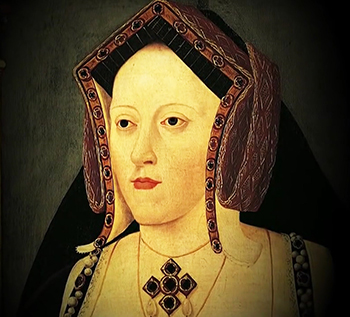
b. 16 Dec 1485; d. 7 Jan 1536.
Youngest daughter of Ferdinand II and Arabella of Spain, first wife of Henry VIII, and mother of the future Queen Mary I of England. Her inability—despite a number of pregnancies and miscarriages—to give Henry VIII a male heir led eventually to Henry's request from the pope for an annulment of his marriage so that he could remarry, the refusal of which led to the break of the Church of England from Rome.
☰ Open Family Tree (Generation 2)

Catherine was first married to Prince Arthur, the eldest son of Henry VII and brother of Henry VIII, in 1501. Arthur, however, died a few months later. For reasons of political expediency, permission was sought and given by Rome (on the grounds that Catherine's marriage to Arthur was never consummated) for Henry VIII to marry Catherine. Again for reasons of political expediency, the marriage, however, could not take place until Henry VIII could assume the throne after his father's death, thirteen days before his coronation on 24 June 1509.
The couple seemed genuinely in love during the early years of their marriage, and Catherine—with a breadth of intellectual interest and ability to match her husband—often stood in as regent, taking care of the business of running the country, when her husband was abroad campaigning against the French (she was, in fact, responsible for the most famous of the military victories—against James IV of Scotland at the Battle of Flodden in 1513—during Henry's reign).
Catherine was repeatedly pregnant but of the four daughters and two sons, only Mary I, born in 1516, survived. Catherine's inability to give Henry a male heir became the king's "great matter." Henry's appeal to the Pope for an annulment of his marriage went nowhere, and in the end Henry resorted, with the help of Thomas Cromwell, to some of the vilest means to discredit Catherine in order to force a divorce and in the process making the break with Rome and the kings as the "Supreme Head of the Church of England." On 23 May 1533, Henry married Anne Boleyn; five months later the archbishop of Canterbury, Thomas Cranmer annulled Henry's marriage to Catherine.
Despite being a foreigner, Catherine was always loved by the common people of England. Henry forced her into retirement and isolated from public life as well as access to her daughter Mary. She never recognize her divorce and in a letter to Henry written just hours before her death (of a cancerous tumour around her heart) she signed it "Catherine the Queen." On hearing the news of her death, Henry was reported to have said, "God be praised. We are free of all suspicion of war," referring to the possibility of Charles V, the Holy Roman emperor and nephew of Catherine, marching against England. Four months afterwards, Anne Boleyn followed Catherine, not by way of a natural death, but beheaded on charges of adultery.

Further Reading:
Giles Tremlett, Catherine of Aragon. Henry's Spanish Queen (London: Faber & Faber, 2010).

©ALBERITH
210216lch